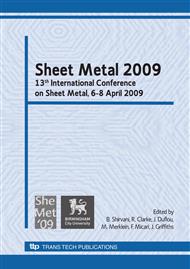p.347
p.355
p.365
p.373
p.381
p.391
p.401
p.413
p.421
Application of Neural Network Technique to Predict the Formability in Incremental Forming Process
Abstract:
Nowadays, several researchers all over the world on Incremental Sheet Forming are focused on formability analysis and, in particular, on the development of a model able to predict material response also in the design phase. Focalising the attention on this aspect and taking into account the literature review, it is possible to establish that both numerical and analytical approaches were utilised to justify the experimental evidences. Anyway, many efforts are spent in order to define new models to predict material breakage during incremental forming of simply shaped components. On the contrary, the availability of a predictive model able to detect failure insurgence, based on the products geometry, is a relevant issue to improve industrial application of incremental forming process. At the same time, it still represents an open point of the current scientific research. According to this aim, a preliminary analysis was executed to detect the factors that deeply impact on the process performance. In a subsequent analysis, a robust Neural Network was built in order to define a more reliable tool for calculating the allowable component height when a multi-slope trajectory is imposed. The reliability of the proposed approach was tested executing some experimental results. All the details are accurately discussed in the paper.
Info:
Periodical:
Pages:
381-389
Citation:
Online since:
March 2009
Authors:
Price:
Сopyright:
© 2009 Trans Tech Publications Ltd. All Rights Reserved
Share:
Citation:


